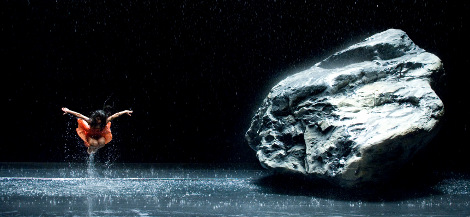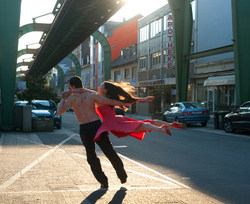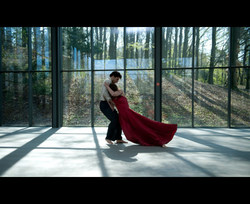

Heavy-hitting filmmakers are turning their cameras on dance and it's an honor. It's also a puzzlement, to the dance world. It surprises us. We thought that the only folk attending dance performances were fellow dancers, parents, and dance critics. But clearly we were wrong. Other artists -- filmmakers -- love dance too.
With Pina, German cinema legend Wim Wenders joins the recent ranks, which include American documentarian Frederick Wiseman (La Danse), the Briton Mike Figgis (The Co(te)lette Film), and indie guy Darren Aronofsky (Black Swan), in crafting rapturous, high-tech paeans to the art form. Wenders's current wonder is shot with 3D technology and there's a lot of excitement over the cinematographic skill employed.
On the surface, Pina's vast and generous showcase of the German choreographer Pina Bausch's Tanztheater ensemble seems to serve dance well. Beyond beautifully photographed, it's sumptuous and cannot be more visually engaging.
The best parts, the brilliant bits, of Pina, may emanate not from the choreographer but from the filmmaker. Wenders removes Bausch's work from the theater, and places it in the startlingly tidy German countryside (everything in this film is immaculate). A dancer frolics in the grass, toying with her colorful chiffon skirt. A duet transpires on a stunning glass-walled outdoor platform. Back in the city, the man and woman twirl at street level, beneath an elevated commuter rail track. Also gripping are the sequences shot in the mills and factories of Wuppertal, the central German town where the dance company is based. A male dancer, flopped onto the platform of what looks like a steel mill, moves his limbs like a broken puppet. Industrial supply cars glide silently behind him. What a vision. There's an extremely wry sequence -- gee the whole thing is so severe you dare not laugh out loud -- clowning in a tram car. This material is amazing to watch, memorable, transcendental. Bravo, Wim Wenders.
Bausch is admittedly not my favorite dance maker. What on earth is she trying to say? Even if I got part of it, it would be acceptable. I see that she's gathered a colorful tribe, and employs a theatrical, plastic visage to make it all human. But I don't recognize the people. The look doesn't help me -- unkempt hair, loose breasts, grandma sack-style dresses, lingerie-slips, ball gowns worn by bohemians. The male contingent is even weirder, in retro suits with bare feet. The staring, hanging, clinging, clawing, dropping and, above all, the suffering -- to what end? It's strikes me as very sad. The old-tyme music grates; I don't care to remember Germany in the 1930s unless I absolutely must. I fail to meld as an audience member with this artist.
 The studio and theater scenes, delivered in bits and pieces, are grounded in Bausch's signature piece, the unbearably opaque "Cafe Muller," which has not aged well. Dancers sliding down walls, overturning chairs, the purposeful ugliness feels irrelevant.
The studio and theater scenes, delivered in bits and pieces, are grounded in Bausch's signature piece, the unbearably opaque "Cafe Muller," which has not aged well. Dancers sliding down walls, overturning chairs, the purposeful ugliness feels irrelevant.
So what's at the heart of this movie? Not a documentary, it provides no artistic context. The film assumes Pina Bausch matters -- a lot. I was waiting to hear from the grizzled German dance critic, a chain-smoking "Sprockets" guy, who's devoted a lot of time thinking deeply about Bausch's art. But he's not in the picture. Instead, the precious explanatory moments are devoted to sound bites by infatuated dancers, e.g., "Pina told me 'be more crazy'... " Touching because the grief-stricken dancers memorialize Bausch so soon after her death, nonetheless, these commentaries are not of real use to civilians.
Does Pina deepen our connection to a mystery-plagued art form? That's what I care about. Dance needs fewer Martians and more Earthlings; less obfuscation, more clarity. We need humane, direct communication with audiences. At the screening I attended, the response was muted. I wonder how many new dance friends Pina will make.
Pina opens in Los Angeles on January 13, nationwide thereafter.
Photos: ©Neue Road Movies GmbH, Photo by Donata Wenders. A Sundance Selects release.
Debra Levine is a Los Angeles-based arts journalist blogging about dance, film, music and urban culture on arts•meme.
Read more 'dance-film' reviews by Debra Levine:
- Darren Aronofsky"s Black Swan
- Frederick Wiseman's La Danse

